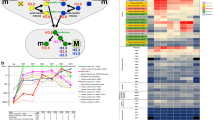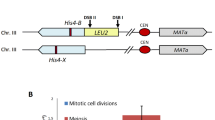Abstract.
In the ciliated protozoan, Tetrahymena thermophila, the diploid germinal micronucleus contains two allelic copies of the gene for ribosomal RNA (rDNA). During genesis of new somatic macronuclei the germline rDNA gene is excised by developmentally programmed chromosome breakage and preferentially amplified to ∼9,000 copies. We have studied this process by fluorescence in situ hybridization. We find that initially rDNA amplification is restricted to two separate and highly confined regions of the nucleus. Analysis of nuclei that are hemizygous for the rDNA locus reveals that each focus of hybridization is derived from a single allele of the rDNA. As rDNA amplification progresses these two foci of hybridization disperse and spread throughout the macronucleus, eventually forming ∼100–500 new nucleoli. These events are correlated with morphologically distinct developmental stages. We investigated the amplification of the C3 allele of the rDNA that confers a replication advantage over the B allele during vegetative propagation, and find no evidence for preferential amplification of the C3 early in rDNA maturation. We also show that the rmm 11 rDNA mutant allele, which is defective for developmentally programmed rDNA excision, can be amplified during the two-foci stage in mutant homozygotes and heterozygotes, but fails to amplify further and disperse into multiple nucleoli. These data indicate that amplification of the rmm 11 allele is not delayed during the initial rounds of amplification, and suggest that efficient excision is not required for this amplification to occur. We propose that rDNA amplification is a two-step process. First, the two rDNA alleles are independently amplified, while allelic copies remain closely associated. Later, copies of the rDNA disperse and are further amplified, presumably because rDNA excision has occurred, generating fully mature rDNA minichromosomes that are able to replicate to high copy number.
Similar content being viewed by others
Author information
Authors and Affiliations
Additional information
Received: 21 February 1997; in revised form: 21 April 1997 / Accepted: 5 May 1997
Rights and permissions
About this article
Cite this article
Ward, J., Blomberg, P., Hoffman, N. et al. The intranuclear organization of normal, hemizygous and excision-deficient rRNA genes during developmental amplification in Tetrahymena thermophila . Chromosoma 106, 233–242 (1997). https://doi.org/10.1007/s004120050244
Issue Date:
DOI: https://doi.org/10.1007/s004120050244




